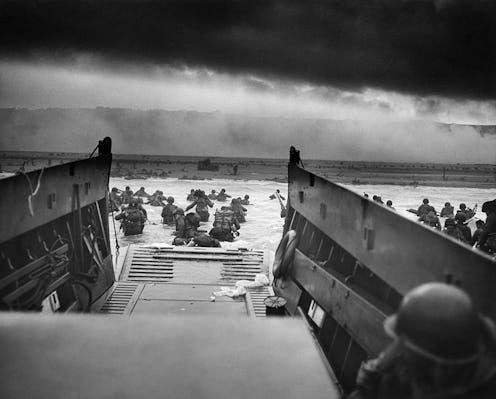News
4 Things You Didn't Know About D-Day

This Friday is the 70th anniversary of the Allied forces' D-Day landing at Normandy during World War II. The landing, and the subsequent massively lethal battle at Omaha Beach, would ultimately claim the lives of thousands of Allied troops, and was pivotal in launching the ground invasion of Europe that ultimately overtook and defeated the Nazis. Seven decades on, and its memory has not been forgotten — from an American perspective, it's arguably the most storied military operation of its era.
You've probably learned a lot of things about it through the years: the treacherous weather, the inopportune but essential timing of the attack, the bravery expressed in pursuit of an incredibly dangerous mission. Still, there are a bunch of things you don't know. Yeah, D-Day was a long time ago, but the staggering accomplishment of those World War II Allies, in toppling the Axis forces and freeing Europe from the ever-expanding tide of Nazi control, deserves notice no matter how long ago it all took place.
So here are four things you might not have known...
1. It Wasn't Only About Omaha Beach
The iconic image of brave Allied soldiers sprinting up Omaha Beach from the water's edge is probably at the forefront of your mind when the words "D-Day" are spoken aloud. And this makes a ton of sense, because that's the iconic representation of Allied mettle and courage which subsequent retellings of the story always push to the front — it was the deadliest of the landings that day, owing to it's high cliffs.
But it wasn't the only place the Allies entered France that day. The shoreline was actually divided into five landing points — Omaha, Utah, Gold, Juno and Sword. Nor was a nautical landing the only way the Allies entered into France, with about 25,000 more having been parachute-dropped into France the preceding midnight. As such, the Allies had an overwhelming numerical advantage over the Axis defenses stationed along the coast, outnumbering their soldiers by about three-to-one. This wasn't enough to avoid heavy casualties, however — including the horrific loss of life at Omaha, the Normandy invasion killed upwards of 4,000 Allied forces.
2. There Could Have Been a Lot More Photos
Unfortunately for us, and for history, only about a tenth of the snapshots that famed war photographer Robert Capa took that fateful day survived to be released. This is due to a hapless, teenage assistant named Dennis Banks, who while working in Capa's darkroom dried his 106 D-Day photos on so high a temperature it destroyed all but 11 of them. (Teenagers, eh?)
Capa was one of the world's most storied war photographers, having covered five wars before being killed by a landmine in 1954.
3. It's Wasn't the First D-Day, Nor the Last
The term "D-Day" doesn't refer specifically to the World War II offensive, but is a generic military term that refers to the day an operation begins. The actual title of the mission, in the days and months before it took place, was a bit more dramatic-sounding: Operation Overlord was the moniker for the full-scale operation, while the Normandy landings were called "Operation Neptune."
The D-Day name has been used for countless other military operations as well, and is used as a means to make date-keeping simple. There's also a designation for the specific time an operation is to start, called H-Hour.
4. Some Names You Might Recognize Stormed Those Beaches
There were a couple of men that day who would go on to high-profile, storied careers in arts and entertainment. The biggest name, in spite of the intensely reclusive life he'd eventually come to embrace, was probably that of J.D. Salinger. His unfinished novel, The Catcher in the Rye, was tucked away in his backpack during the siege.
The other high-profile name was a man of the TV screen. Former Star Trek actor James Doohan, better known as lovable chief engineer "Scotty," was also among those Allied troops fighting on the shores — he came out of it wounded, shot six times by a mistaken Allied sentry. One of the bullets bound for his chest halted by a cigarette case in his breast pocket, given to him by his brother.
Images: Public Domain/Wikimedia Commons